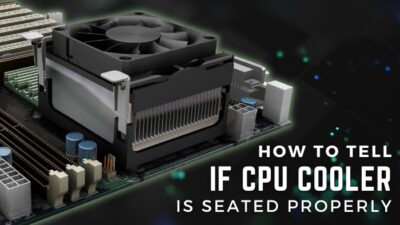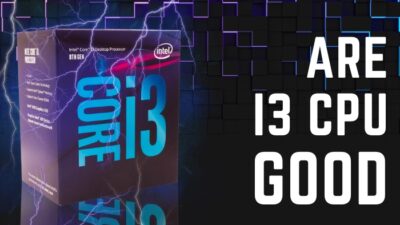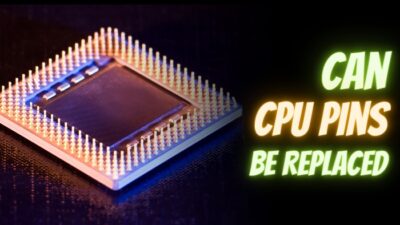Are you building your first computer? And you got confused by seeing all the power supply cables? Among the PSU cables, you see two identical cables marked one PCIe and another for EPS. As they look the same, you wonder can you interchange these two?
I can empathize with you. Recently, I built my own PC, and I encountered a dilemma. So, I scratched through the internet to find the best suggestions and fortunately got one.
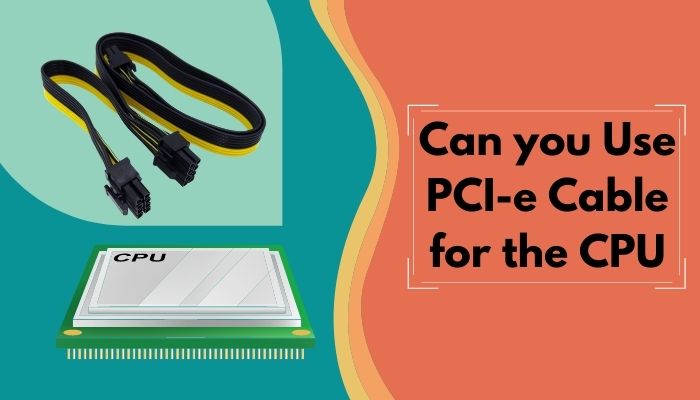
So read this article thoroughly, and you will get your answer and also some other valuable things.
Is it Possible to Use a PCI-e Cable for the CPU?
NO, it’s not possible to use PCI-e cable for powering the CPU. Do not do that because by doing this, you may shortcircuit the entire system and also can damage the system permanently. The main cause is both PCIe cable, and EPS look the same but have different power factors.
When Building a desktop, you have to deal with various types of cable. Different types of cable are used for different purposes because they all have different types of construction. For example, The SATA cable is used for wiring the motherboard and the HDD.
However, there are two similar-looking cables The PCI-e 8pin or 6+2pin and the EPS cable. PCIe and CPU cable look exactly the same, and it’s difficult to differentiate if there were no markings on the cable head.
The PCI-e connector has 3 12V lines and 5 ground lines. On the other hand, the CPU power connector has 4 12V lines and 4 ground lines. So there is a direct shortage of 12V. So if You try to connect the PCI-e cable in the EPS slot, then in the pin of the 12V line, you will connect a Ground line.
So if you do this, in most cases, the CPU won’t power up. But in sudden cases, it can blast into your mouth.
What are the Types of Power Cables?
Cables are like a bridge. They mainly connect two different components by wiring. The PSU or the power cables are mainly used for supplying the power to different components. The power cables are mainly divided into five types.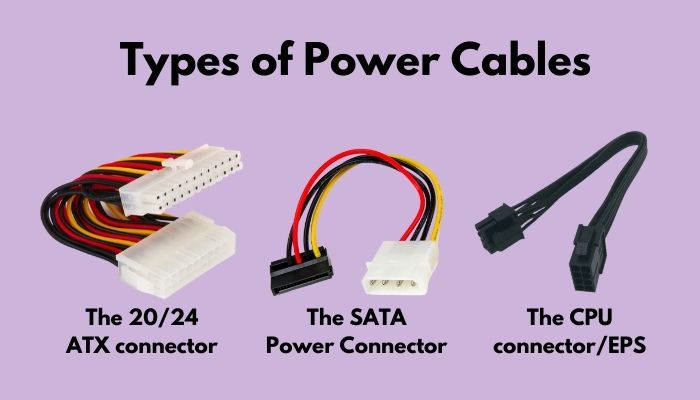
- The 20/24 ATX connector
- The CPU connector /EPS
- The PCI-e Connector
- The SATA Power Connector
- Molex Connector
However, some of them may look similar, but they are not interchangeable.
Here Different types of PSU cables are explained below :
The 20/24 ATX connector:
The 20/24 pin connector is the main connector that connects the motherboard or anything connected to it.
Most motherboards these days will require or use the 24-pin connector then the 20-pin connector. Because the extra 4 pin provides power to the PCI Express slots, the PCI Express slot is where you place your GPU.
But the GPU usually requires additional power. Some graphics cards can be powered by the PCI slots alone; they don’t need additional power cables to operate.
The 20/24 ATX connectors are keyed and can only fit the motherboard.
The CPU connector /EPS
The next cable to talk about is the CPU 8-pins or 4-pins EPS. This connector provides power to the CPU socket. Your PC will not be able to function without connecting the EPS cable.
The EPS cable will be KEYED and may also be labeled to help identify it because it looks similar to the PCI-e cable.
There are a few different possibilities of what connectors your board may have. They can be A
- 8-pin
- 4-pin+4-pin
- Or 8-pin+4-pin
- Or an 8-pin+8-pin
The 4-pin supplies about 155 watts, and the 8pins or the (4+4)-pins will supply about 235 watts.
It’s possible to function your pc on 8-pin alone if you don’t put too much pressure.
However, If you plan to overclock, make sure all the cables are to the available EPS slot; otherwise, your CPU will not be Stable.
Excluding the above connector, if you have a VGA cable connector, you can’t use a VGA cable with the CPU as a power connector. Because it only works with the graphics card to provide power.
The PCI-e Connector:
Next here is the PCI express Cable, mainly known as PCI-e Cable. The PCI express cable is mainly for providing power to the GPU.
Now The ATX connector provides 75watts to the PCIe slots. But high-end graphics cards will require more than 75w to function and maintain stability. There are some low-end GPUs that can function at 75 watts.
However, for more Power-hungry GPUs, you need to connect the 6-pin or 8-pin connector to function properly.
The PCI express cable comes in the form of a 6-pin+2pin connect with your power supply. Usually, the 6pin provides the power and the additional 2pin for the Ground. Your High-end GPU can require up to 2 of the 6-pin+2pin connectors. So before Buying your PSU verify if it has the required cable
The SATA Power Connector
The serial advanced technology attachment cable is known as SATA cable.
This Cable power the SSD, HDD, and in some cases the DVD or CD drive. They also power the RGB and the FAN hubs and also some AIO. SATA cables usually have 16 pins with i shaped design.
But your M.2 SSD is not powered by it because of the M.2 SSD integrated port in your motherboard.
Molex Connector
Molex cables were used for connecting the older motherboard, the fans, and some floppy disk drives.
Technically the Molex connector flows more power than the SATA cable. It has 2 large pins of 12V and 5V. But it is not suitable to use as the SATA. The pins never landed right in the connector; there was a high risk of bending the pins and getting a shock.
So newer power supply replaces the Molex connector with a SATA cable.
PCI-e Cable vs. EPS Cable: Which One is Suited for CPU?
The PCI-e Cable and EPS Cable are almost identical. They look so same as if there is no written tag, then you could not identify them. But the PCI-e cable is for the GPU power, and the EPS cable is for the CPU.
Why? You may ask.
The main reason is both of them provide different types of amounts of a volt. So you can’t interchange the PCIe and EPS cable. The EPS Connector flows the current of 130 watts; on the other hand, the PCI-e Cable flow 75 watts for 6pins and 150 watts for an 8-pins cable.
Now you can ask what will happen if you accidentally interchange them?
Technically you cant plug the EPS connector into the graphics card as well as the PCI-e Cable to the motherboard. If you somehow forcefully plug up, either the GPU will fry or the processor will damage.
The main cause of that situation to happen is, The EPS has a higher watt than the PCI-e Cable. So if you interchange this, then you will give more power to the GPU and less power to the CPU.
Types of PCI-e Cables:
The PCI-e Cable is used for powering up the GPU. Because the motherboard can’t fulfill the power need of the high-end GPU. Mainly 3 types of PCI-e Cables are available in the market.
Here are the 3 types of PCI-e cables described:
6-pin connector:
The 6-pin connector supplies an additional 75watt of power besides the basic PCI slots. So the GPU can draw 75+75 watts of power. The 150 watts is enough for most graphics cards. The PEG cable used in the computers is also a 6-pin connector.
8-pin connector:
The 8-pin connector delivers 150watt of power to the GPU with a base of 75 watts. For example, the Nvidia GeForce RTX 3060 needs 170watts of power. So it has both a 6pin connector and an 8pin connector to fulfill the power needs.
There are some exceptional cases where there are two 8-pin connectors in some GPU. That GPU overclocks better than other types of GPU.
12-pin connector:
With the release of NVIDIA’s RTX 3000 series, the 12-pin connector is introduced into the market. It is the same size as the 8-pin connector, but it draws more power.
BUT the available PSU in the market doesn’t always have a 12-pin connector. SO NVIDIA also releases the adapter to convert 2 6-pin connectors into one.
Conclusion
In summary, The PCIe cable and EPS connector both look the same but are different in function. You can’t technically interchange PCIe & EPS because of different power flow. If You force them to interchange, then you will damage your system permanently.
After reading this article I’m sure you now have the proper answer to the question you asked in the beginning “Can you use PCI-e Cable for the CPU?”. And also now you know the consequences of doing so.
If you arise any kinds of questions fill free to ask me. Thank you.

